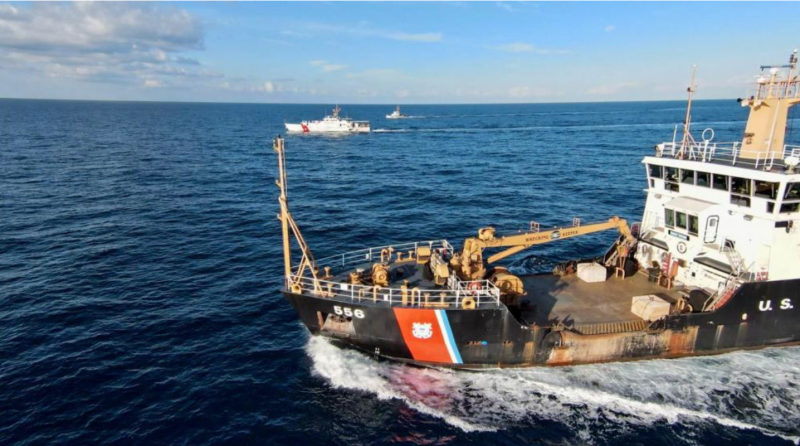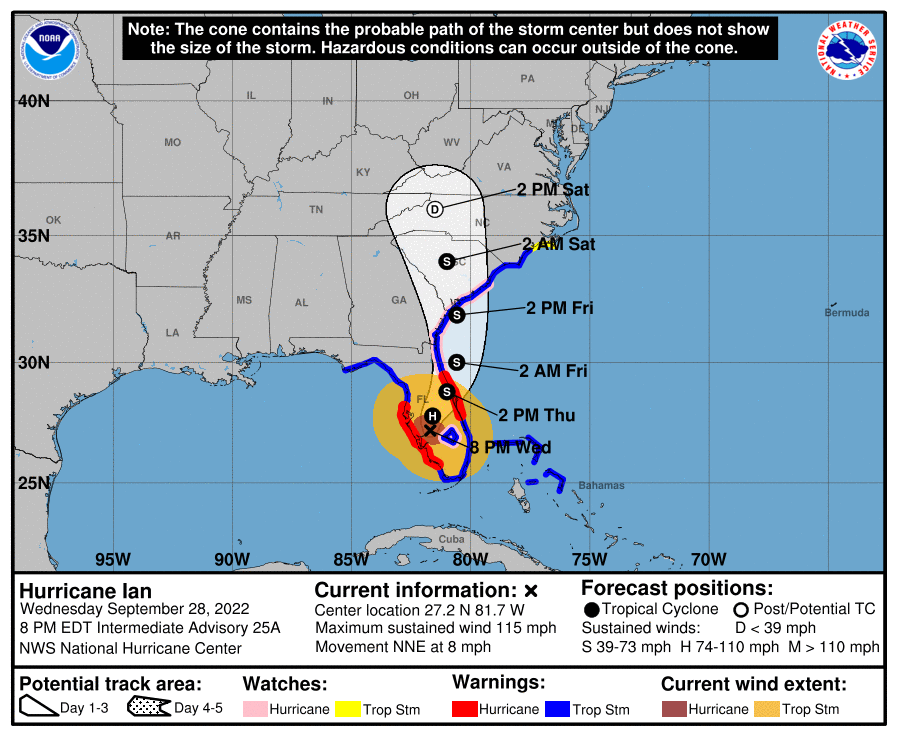Spinning out wind gusts to 190 mph, hurricane Ian made landfall at 3:05 p.m. Wednesday near Cayo Costa State Park on the southwest Florida coast, pushing storm surges that swamped neighborhoods in Fort Myers and continued into the evening.
Record surges rolled into the streets of Key West and Naples as Ian made its way north overnight into Wednesday as a powerful category 4 storm with sustained winds to 155 mph. Authorities warned that surges as high as 12 feet could continue into Thursday morning. A tide gauge at Bonita Beach reported a rise to more than 10 feet around 6:15 p.m. as Ian weakened to a category 3 and pushed northeast toward Orlando.
With continuing high water and an estimated 2 million electrical customers out of power, curfews were imposed from Naples north to Tampa. The industry group Edison Electric Institute said almost 33,000 utility workers in 31 states are mobilized to assist in the post-storm recovery.
Winds were forecast to slowly ease toward category 1 as the storm makes its way across the Florida peninsula, but the system is predicted to broaden into a wider, prolonged rain event.
At a press conference late Wednesday afternoon Gov. Ron DeSantis said emergency responders are prepared for inland flooding in northeast Florida around the St. Johns River flowing through 12 Florida counties. DeSantis asked the Biden administration for a federal disaster declaration covering all 67 Florida counties.
The port of Tampa had been closed as Ian approached, and shortly before landfall on the Gulf side of the state, the Coast Guard declared port condition Zulu for Jacksonville, closing that port pending the storm’s passage. Forecasters predict Ian will move out onto the Atlantic as a tropical storm, before moving northwestward toward the South Carolina coast.
As a powerful category 4 hurricane, approaching category 5 with gusts to 190 mph, Ian appears on track to rival hurricane Andrew in 1992 as a historic storm for Florida.
Thirty years later, southwest Florida’s population and urban development has swelled. Cape Coral, and extensive canal-front residential community east of Fort Myers, and island communities like Pine Island and Sanibel lay exposed to the storm’s strongest winds in the peak flood zone extending northward toward Sarasota. At nightfall authorities around Fort Myers were awaiting safer wind conditions before sending out crews for rescue missions and damage assessment.
“When wind conditions subside to 45 miles per hour, we’ll be out,” Cape Coral Mayor John Gunter told CNN. Hundreds of calls from residents told of flooded homes, failed roofs and other damage, he said.
Preparing for rescue and response operations, the Coast Guard Seventh District established an area command post at the Coast Guard air station at Opa Locka in Miami-Dade County.
“The Coast Guard is here and ready to fully support the State of Florida in our shared response to Hurricane Ian,” said Capt. Nicolette Vaughan, chief of prevention for the Seventh Coast Guard District and IMT Area Commander for the Hurricane Ian incident response team. “Our primary focus is to rescue those in distress. Our next focus will be to reopen the ports affected as soon as possible to ensure vital resources and supplies are delivered where they are most needed.”
The Seventh District has mobilized and prepositioned units across Florida, prepared to surge into damaged areas for search and rescue resources. Port reconstitution teams are standing by to restore maritime infrastructure. and emergency respond needs the Coast Guard can provide. A list of assets now committed includes:
- Aircraft: 21 rotary wing and 9 fixed wing aircraft able to locate and rescue persons in distress.
- Cutters: 31 multi-mission search and rescue ships, 4 buoy tenders and 3 construction tenders to service aids to navigation.
- Flood response teams: 40 shallow water response teams able to access those stranded by the storm surge and heavy rain.
“Post storm, crews will take to the water, assessing port conditions, identifying safety concerns to protect mariners and restore the maritime commerce and tourism industries that Florida depends upon,” according to a Coast Guard statement.








